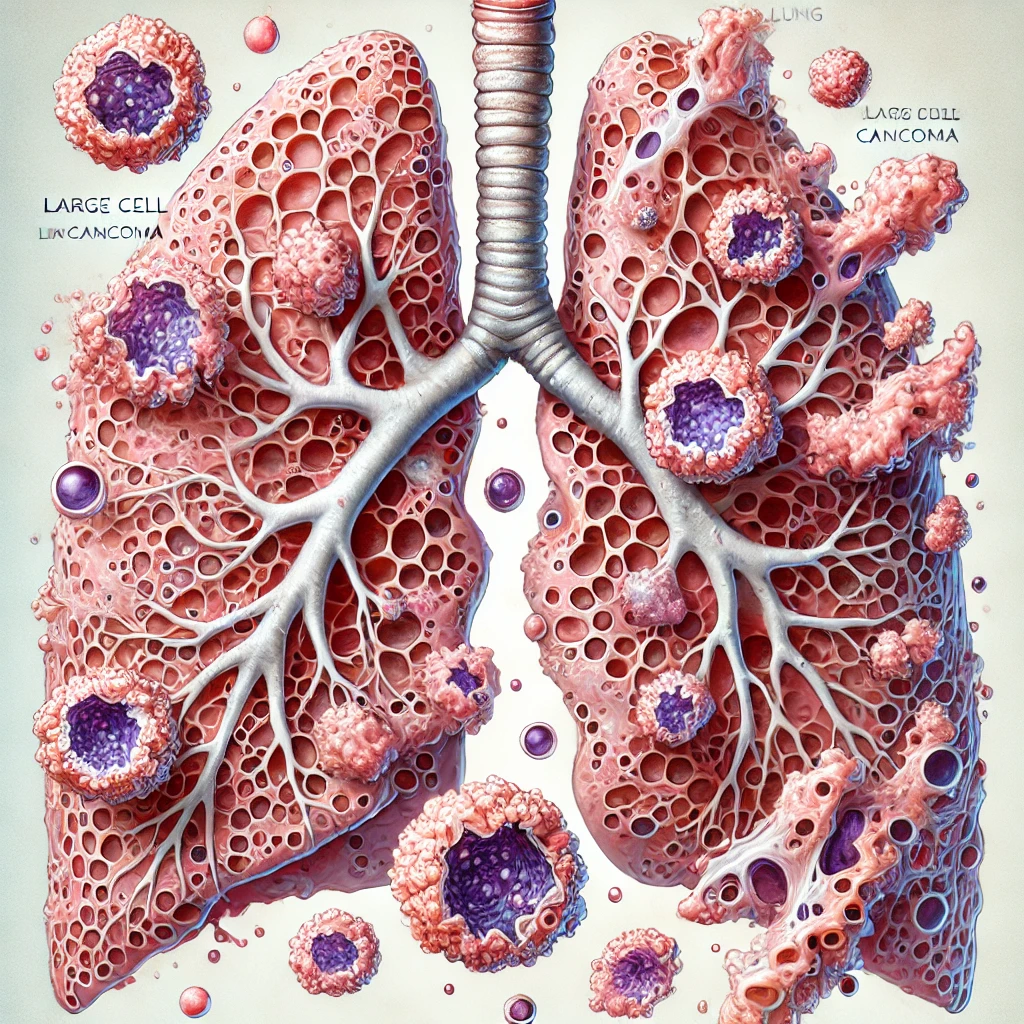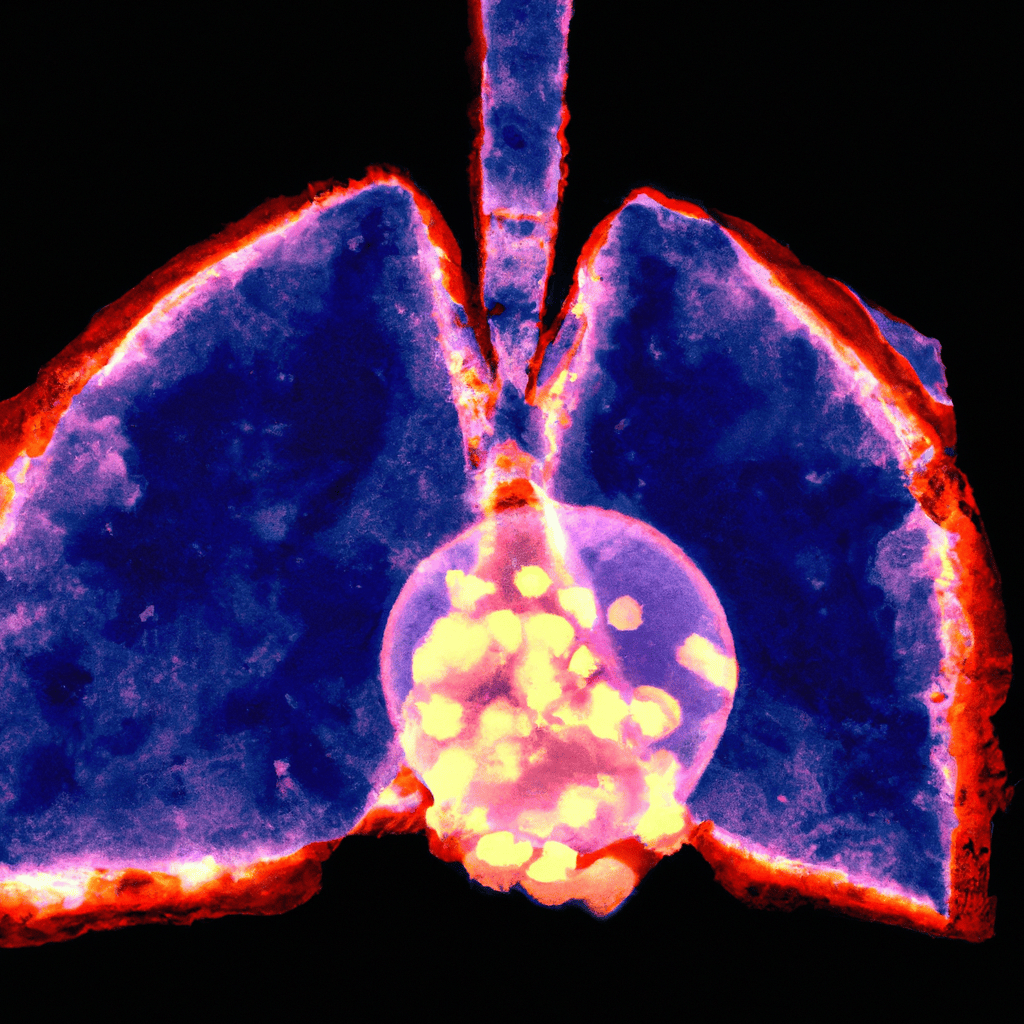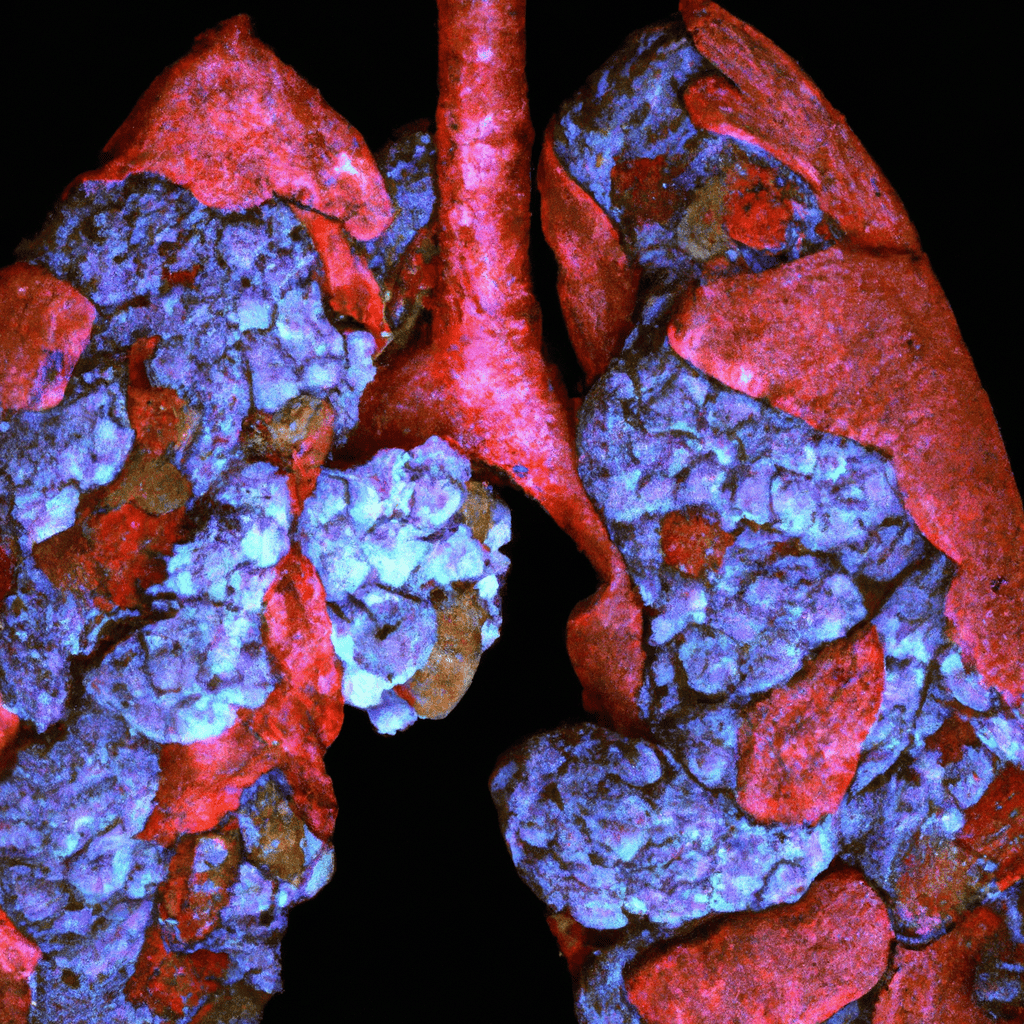Understanding Large Cell Lung Carcinoma with Rhabdoid Phenotype

Large cell lung carcinoma with rhabdoid phenotype is a rare and aggressive form of lung cancer. It accounts for only 0.1% to 1.0% of all lung malignancies, with approximately 1% of large cell lung carcinoma cases developing this phenotype. This cancer spreads rapidly, often reaching the liver, brain, and bones early in its course. Its distinct aggressiveness, marked by swift metastasis through lymphatic and blood pathways, sets it apart from other lung cancers. Understanding this condition is crucial for advancing lung cancer research and improving treatment strategies.
Key Takeaways
Large cell lung carcinoma with rhabdoid type is a rare, fast-growing lung cancer. It makes up only 0.1% to 1.0% of all lung cancers.
Finding it early is very important. Symptoms like a long-lasting cough or chest pain need quick medical care to help treatment work better.
Doctors use scans, tissue tests, and special lab tests to check for certain genetic signs of this cancer.
Treatments include surgery, strong medicines (chemotherapy), and special drugs that target the cancer. Scientists are working on better treatments.
Joining research studies and helping cancer research can improve treatments and help people live longer with this rare cancer.
What Is Large Cell Lung Carcinoma with Rhabdoid Phenotype?

Definition and Classification
Large cell lung carcinoma with rhabdoid phenotype is a rare subtype of non-small cell lung cancer. It falls under the category of large cell carcinomas due to its undifferentiated nature. This cancer is characterized by unique histological features that distinguish it from other lung malignancies. These features include oval to polygonal cells, abundant eosinophilic cytoplasm, and eccentric nuclei with prominent macronucleoli. The table below highlights these defining characteristics:
Feature | Description |
|---|---|
Cell Shape | Oval to polygonal |
Cytoplasmic Features | Eosinophilic, hyaline-like perinuclear agglomerations of intermediate filaments |
Nuclei | Compressed, eccentric nuclei with prominent central macronucleoli |
Cytoplasm | Abundant eosinophilic cytoplasm |
Chromatin | Reticular chromatin pattern |
These histological traits help pathologists identify and classify this aggressive cancer type.
Rarity and Aggressiveness
You may not often hear about large cell lung carcinoma with rhabdoid phenotype because of its rarity. It accounts for only 0.1% to 1.0% of all lung cancers. In one study of 902 surgically resected lung cancers, only three cases (0.3%) were identified as having this phenotype. Another study found that just 4 out of 45 large cell lung carcinoma cases (9%) displayed rhabdoid features. Despite its uncommon occurrence, this cancer is highly aggressive. It spreads quickly to vital organs like the liver, brain, and bones, making early detection and treatment critical.
Importance in Lung Cancer Research
Understanding large cell lung carcinoma with rhabdoid phenotype is vital for advancing lung cancer research. This cancer is linked to specific genetic mutations, such as those in the CK-8 gene. These mutations open the door for developing targeted therapies, including monoclonal antibodies. Researchers also recognize the need for early diagnosis and aggressive management to improve survival rates. However, challenges like the tumor's rarity, complex biology, and early metastasis make studying it difficult. By addressing these challenges, scientists can develop better treatments and improve outcomes for patients.
Defining Characteristics of Large Cell Lung Carcinoma with Rhabdoid Phenotype
Histological Features
When you examine large cell lung carcinoma with rhabdoid phenotype under a microscope, its unique histological features stand out. These tumors consist of cells with an oval to polygonal shape. The cytoplasm appears eosinophilic and contains hyaline-like perinuclear inclusions formed by intermediate filaments. The nuclei are eccentric, with prominent macronucleoli and a reticular chromatin pattern. These features help pathologists identify this rare and aggressive cancer.
Molecular and Genetic Markers
This cancer type exhibits distinct molecular and genetic markers. You can find the following markers commonly associated with it:
Epithelial membrane antigen (EMA) – expressed in 61% of cases.
Cytokeratins (CKs) – present in 80% of cases.
Vimentin – nearly 100% expression in rhabdoid cells.
Thyroid transcription factor-1 (TTF-1) – less frequently expressed compared to other lung cancers.
Neuroendocrine-related markers like neuron-specific enolase and synaptophysin – frequently observed.
Granulocyte-macrophage colony-stimulating factor (GM-CSF) – linked to aggressive dedifferentiated cells.
Genetic mutations also play a role in this cancer's development. Mutations in the cytokeratin 8 (CK-8) gene and cytokeratin 18 are common. Changes in vimentin protofilaments further contribute to the tumor's aggressive behavior. These markers and mutations provide valuable insights for diagnosis and treatment.
Clinical Presentation and Symptoms
Patients with large cell lung carcinoma with rhabdoid phenotype often experience symptoms similar to other lung cancers. You might notice persistent coughing, shortness of breath, and chest pain. Fatigue and unexplained weight loss are also common. In advanced stages, symptoms may worsen due to metastasis to the liver, brain, or bones. Early detection is crucial because this cancer progresses rapidly.
How Is Large Cell Lung Carcinoma with Rhabdoid Phenotype Diagnosed?
Imaging Techniques
Imaging plays a crucial role in identifying large cell lung carcinoma with rhabdoid phenotype. You may notice that this cancer often appears as single "coin lesions" or discrete masses on imaging scans. In some cases, multiple nodules spread throughout the lung. CT scans frequently reveal inhomogeneous consolidation, which can indicate the presence of necrosis or cavitation in larger, centrally located tumors. Additionally, large bullae may sometimes accompany this condition. These imaging features help differentiate this rare cancer from other lung malignancies.
Tip: Early imaging can help detect abnormalities before symptoms worsen, improving the chances of timely intervention.
Biopsy and Histopathological Analysis
A biopsy is essential for confirming the diagnosis. Pathologists typically perform a Tru-cut biopsy to collect tissue samples from the lung lesion. The histopathological analysis reveals tumor cells with eosinophilic cytoplasmic globules and eccentric nuclei. Immunohistochemistry further aids in diagnosis by identifying specific markers. For example:
Evidence Type | Description |
|---|---|
Biopsy | Tru-cut biopsy from the lung lesion revealed histopathological features compatible with LCLC. |
Histopathological Features | Tumor cells with eosinophilic cytoplasmic globules and eccentric nuclei were observed. |
Immunohistochemistry Results | Cytokeratin and vimentin were diffusely positive; thyroid transcription factor was focally positive. |
Other Markers | Desmin, synaptophysin, and calretinin were uniformly negative. |
Diagnosis | Final diagnosis of locally advanced LCLC-RP was reached based on clinical background and analysis. |
This combination of biopsy and histopathological analysis provides a definitive diagnosis, distinguishing large cell lung carcinoma with rhabdoid phenotype from other lung cancers.
Role of Molecular Testing
Molecular testing is another critical step in diagnosing this aggressive cancer. It identifies specific markers that highlight the tumor's unique characteristics. For instance, immunohistochemistry often shows diffuse positivity for cytokeratin and vimentin, while thyroid transcription factor-1 (TTF-1) is only focally positive. These findings help confirm the diagnosis and exclude other malignancies. Molecular testing also uncovers genetic mutations, such as those in cytokeratin 8 and 18, which contribute to the tumor's aggressive behavior.
By combining imaging, biopsy, and molecular testing, you can achieve a comprehensive diagnosis, paving the way for effective treatment planning.
Prognosis for Large Cell Lung Carcinoma with Rhabdoid Phenotype
Factors Influencing Prognosis
Several factors play a role in determining the prognosis of large cell lung carcinoma with rhabdoid phenotype. The tumor's aggressiveness significantly impacts outcomes, as these cancers tend to grow and spread rapidly. The proportion of rhabdoid cells within the tumor also matters. Tumors with more than 5% rhabdoid cells often lead to worse outcomes. Additionally, the presence of other neoplasms, such as adenocarcinomas with rhabdoid features, can further complicate the prognosis. The table below summarizes these factors:
Factor | Description |
|---|---|
Tumor Aggressiveness | LCLC-RP tumors are known to be especially aggressive, leading to a poor prognosis. |
Proportion of Rhabdoid Cells | Higher proportions of rhabdoid cells correlate with worse prognosis, especially above 5%. |
Presence of Other Neoplasms | Other neoplasms, such as adenocarcinomas with rhabdoid features, have been associated with worse outcomes. |
Understanding these factors can help you and your healthcare team assess the severity of the condition and plan treatment accordingly.
Survival Rates and Statistics
Large cell lung carcinoma with rhabdoid phenotype is classified as an aggressive tumor with a poor prognosis. Many case reports highlight short survival times following diagnosis. Tumors with a higher proportion of rhabdoid cells, particularly exceeding 5%, are associated with even worse outcomes. While specific survival rates vary, the overall outlook remains grim due to the cancer's rapid progression.
Note: Early detection and aggressive treatment may improve survival chances, but the rarity of this cancer limits comprehensive data on long-term outcomes.
Challenges in Predicting Outcomes
Predicting outcomes for this rare cancer presents unique challenges. Its aggressive nature often leads to rapid disease progression, making it difficult to anticipate how the condition will evolve. The rarity of large cell lung carcinoma with rhabdoid phenotype complicates data collection, limiting the ability to establish accurate survival statistics. Additionally, unusual recurrence patterns, such as long intervals before the cancer returns, add another layer of complexity. Tumors with a higher proportion of rhabdoid cells further complicate predictions, as they tend to behave more aggressively.
These challenges highlight the importance of ongoing research to better understand this rare and aggressive cancer.
Treatment Options and Research Updates for Large Cell Lung Carcinoma with Rhabdoid Phenotype

Current Standard Treatments
Treating large cell lung carcinoma with rhabdoid phenotype often involves a combination of approaches tailored to the cancer's stage and aggressiveness. For early-stage cases, radical surgical resection remains the primary option. This procedure aims to remove the tumor entirely, offering the best chance for long-term survival.
Chemotherapy plays a significant role, especially in advanced stages. Platinum-based regimens, such as cisplatin, are commonly used. Newer agents like pemetrexed have shown promise in prolonging survival. Taxane-based chemotherapy, including paclitaxel and docetaxel, has even induced complete responses in some cases. Targeted therapies, such as VEGF-blocking agents like bevacizumab, may also be considered. However, these require caution due to potential risks like severe hemorrhage.
In some cases, combining treatments has proven effective. For example, one case study highlighted the success of adjuvant therapy with cisplatin and paclitaxel, followed by gefitinib, which prevented recurrence for over 34 months.
Emerging Therapies and Clinical Trials
Emerging therapies offer hope for improving outcomes in this aggressive cancer. Current research aligns with non-small cell lung carcinoma treatment guidelines. Pemetrexed and taxane-based chemotherapies continue to show effectiveness. Targeted therapies, such as monoclonal antibodies like bevacizumab, are being explored further.
Clinical trials are also investigating new approaches. Researchers are focusing on therapies targeting specific genetic mutations, such as those in the CK-8 gene. These advancements aim to develop more precise treatments that address the unique characteristics of large cell lung carcinoma with rhabdoid phenotype.
Multidisciplinary Care and Future Directions
A multidisciplinary approach is essential for managing this rare cancer. Early recognition and aggressive management improve survival chances. Combining surgery, chemotherapy, and radiotherapy based on individual factors ensures comprehensive care.
Future research focuses on developing monoclonal antibodies targeting mutations linked to the rhabdoid phenotype. Scientists are also exploring ways to enhance the effectiveness of these therapies, such as improving their ability to penetrate cancer cells. These advancements could revolutionize treatment options and improve outcomes for patients.
Large cell lung carcinoma with rhabdoid phenotype is a rare and aggressive cancer that demands attention due to its unique characteristics and rapid progression. You should note its tendency to metastasize early, which often complicates treatment. Early diagnosis plays a critical role in improving outcomes, as it allows for timely and aggressive management. Despite its challenges, some cases have shown long-term survival, even after metastasis, highlighting the potential for better outcomes with advancements in care.
Ongoing research is essential to address the gaps in understanding and treatment. Current therapies often rely on non-specific guidelines, which may not fully address the needs of this cancer. Targeted therapies and clinical trials focusing on its genetic and molecular markers are urgently needed. By prioritizing early detection and innovative treatments, you can help pave the way for improved survival and quality of life for patients.
FAQ
What makes large cell lung carcinoma with rhabdoid phenotype so aggressive?
This cancer grows and spreads faster than most lung cancers. Its unique genetic mutations and molecular markers drive rapid tumor progression. Early metastasis to vital organs like the brain and liver makes it harder to treat effectively.
Can this cancer be detected early?
Yes, but it’s challenging. Imaging techniques like CT scans can identify abnormalities. Early symptoms, such as persistent coughing or chest pain, should prompt you to seek medical advice. Early detection improves treatment outcomes.
Are there specific risk factors for developing this cancer?
Smoking remains the leading risk factor. Exposure to environmental toxins, such as asbestos or radon, may also increase your risk. Genetic predispositions could play a role, but more research is needed to confirm this.
Is this cancer treatable?
Treatment is possible but complex. Surgery, chemotherapy, and targeted therapies are common options. The choice depends on the cancer’s stage and your overall health. Emerging therapies and clinical trials offer hope for better outcomes.
How can you support ongoing research?
You can contribute by participating in clinical trials or donating to cancer research organizations. Raising awareness about rare cancers like this one also helps drive funding and innovation in treatment development.
Tip: Stay informed about advancements in cancer research. Knowledge empowers you to make better decisions for yourself or loved ones.
---
ℹ️ Explore more: Read our Comprehensive Guide to All Known Cancer Types for symptoms, causes, and treatments.
See Also
Exploring Molecular Characteristics of Lung Giant Cell Carcinoma
A Comprehensive Guide to Diffuse Large B-Cell Lymphoma
Key Insights on Basaloid Squamous Cell Lung Carcinoma
Anaplastic Large Cell Lymphoma: Definition and Treatment Options
Simplifying B-Cell Prolymphocytic Leukemia for Better Understanding
